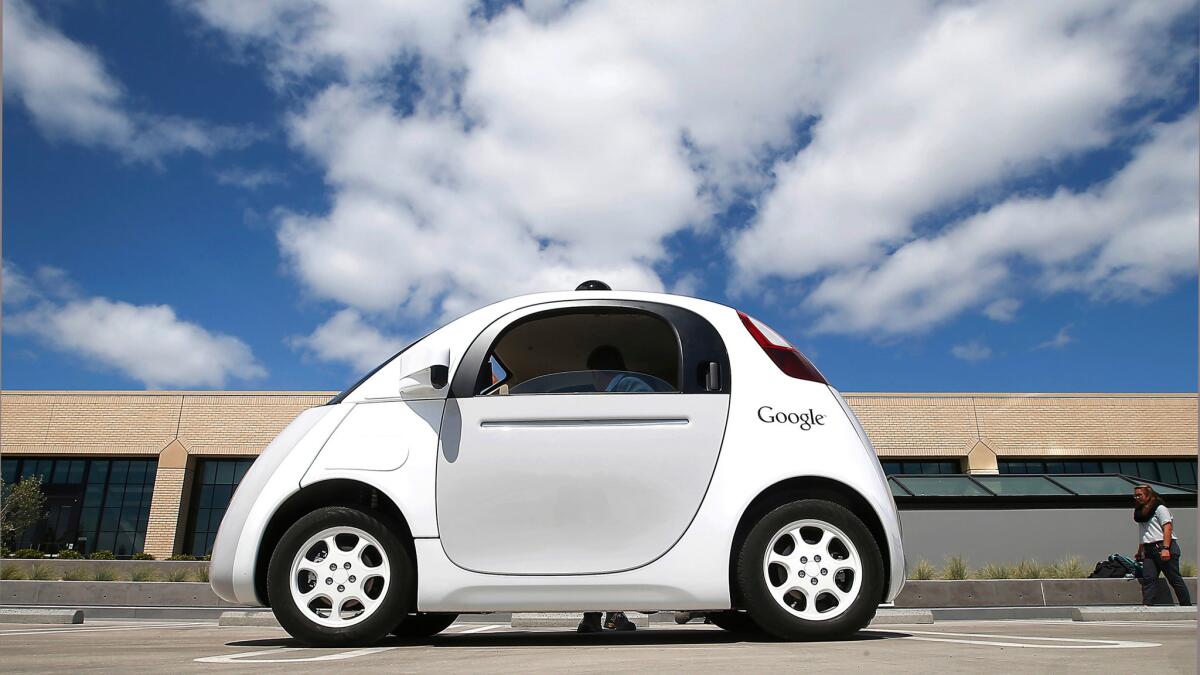U.S. to release guidelines on driverless vehicles

Reporting from San Francisco — Any doubt that driverless cars, trucks and buses are on a fast track to join their human counterparts on the nation’s highways may be knocked aside Tuesday, when the Department of Transportation releases long-awaited guidelines for the development of autonomous cars.
The guidelines, which specify safety criteria and promise to eliminate red tape, will help “bring lifesaving technologies to the roads safely while providing innovators the space they need to develop new solutions,” said the U.S. Department of Transportation in an early summary released Monday.
Automakers and tech companies have been barreling ahead in their race to churn out driverless vehicles, prompting the government to play catch-up when it comes to how to regulate the technology.
Under the guidelines, car manufacturers and researchers will be required to submit to a “15-point safety assessment” for driverless cars, including how the vehicles respond to system failure, whether they make data available for crash reconstruction and even whether their artificial intelligence software takes driving ethics into account.
The Transportation Department will hasten approval or rejection of special exemptions to regulations for driverless cars, with an upper limit of six months. The agency concedes that the process currently can take years.
And acknowledging differences in federal and state regulation, the guidelines will clarify who is responsible for what and recommend new policies that states might adopt to conform to a “national framework.”
John Simpson at Consumer Watchdog said the guidelines “seem to be addressing some of the biggest concerns of safety advocates.”
Despite its support for the technology, the Transportation Department will assert its authority to recall driverless vehicles it deems them to be unsafe — that applies to not just fully driverless cars but those with semi-autonomous driver-assist features as well.
“Part of the agency’s mission is to protect against unreasonable risks,” the summary said. “NHTSA’s existing authority and responsibility covers defects that create unreasonable risks to safety that may arise in connection with” driverless cars.
Automakers are expressing tentative satisfaction.
“We haven’t seen the detailed guidance, but it’s a directionally positive development,” said a Ford Motor Co. spokesman. “We will review the details once they are available.”
Driverless-car advocates are lauding what they see as regulatory flexibility, noting that the guidelines seemed to be more of a loosely defined framework as opposed to a list of hard-and-fast rules.
“These aren’t regulations in the formal sense,” said Bryant Walker Smith, a lawyer and assistant professor at the University of South Carolina. “They are not announcing this as a set policy.”
Increasing computer power and software advances made over the last few years have turned driverless vehicles from science-fiction fantasy to impending reality.
Ford announced it would put driverless cars on the road by 2021. Ride-hailing service Lyft — owned in part by General Motors — said on Sunday that the majority of its cars will be driverless by that time. Driverless Uber cars are already prowling the streets of Pittsburgh.
And driver-assist features — such as parking assist, automatic lane-keeping and adaptive cruise control — that allow cars to drive themselves at least some of the time are growing more powerful and have become popular among drivers.
Automakers had worried that Transportation Department regulations would be too tough; consumer advocates fretted they would be too lax.
Safety, administration officials have made clear, is the top concern. They believe driverless cars will dramatically cut the number of motor vehicle traffic deaths, which last year reached 35,200 nationally, up 7.7% from 2014.
The National Highway Traffic Safety Administration, an arm of the Transportation Department, sees driverless development as part of its mission.
After the fatal crash of a Tesla electric car driven in semi-autonomous Autopilot last May, NHTSA head Mark Rosekind said: “No one incident will stop NHTSA from promoting highly automated driving development.”
The guidelines will be reviewed every year and updated as needed, the Transportation Department said.
In addition to its own guidelines, the administration said it would release “model” guidelines for states, yet to be detailed.
Twitter: @russ1mitchell




